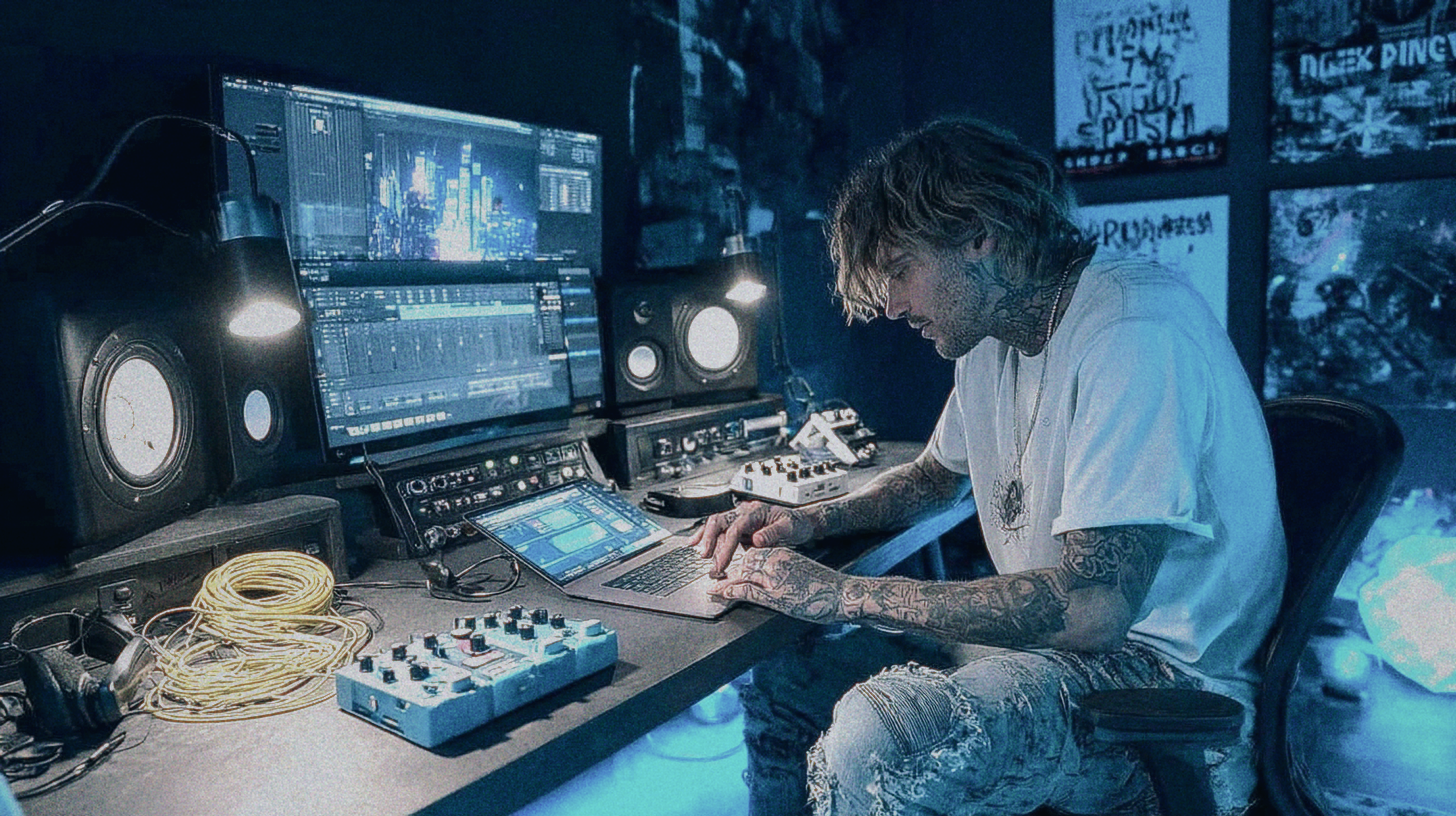
Crafting Intervals’ Modern Guitar Tones with Sam Guaiana
Nail The Mix Staff
Let’s dive into the world of Intervals’ guitar tones. Known for their intricate riffs that feel like vocal melodies, massive soundscapes, and pristine clarity, Aaron Marshall’s guitar work needs a mix that can handle both aggression and detail. So how does producer and mixer Sam Guaiana get that tight, powerful, and articulate sound?
It’s a killer combination of a hybrid re-amping workflow, hyper-specific EQ moves, and creative layering. We’ve got the inside scoop from Sam’s mixing session on how he sculpted the rhythm guitars for Intervals. Forget vague advice; this is a deep dive into the specific tools and techniques you can apply to your own modern heavy metal guitar tracks.
The Core Rhythm Tone: A Hybrid Re-amping Workflow
Getting a solid foundation is everything. For this track, the process started with clean DI tracks, giving ultimate flexibility in the mix. Instead of going purely in-the-box, Sam opted for a hybrid approach, blending a real amp head with a digital cabinet simulation.
From DI to Amp Head
The DIs were re-amped through a Revv 120 head. But here’s the key: they only used the head, not a physical speaker cabinet. To do this safely and capture the pure tone of the amp’s power section, they ran the head into a Suhr Reactive Load. This device mimics the electrical load of a real speaker cab, allowing you to crank the amp and capture its true character without making a sound in the room. This gives you the authentic saturation and response of a tube amp, ready to be paired with any cab impulse or simulator you want.
The Digital Cabinet: Howard Benson Cab Two
With the raw amp tone captured, it was time to give it a voice. Sam’s choice was the Howard Benson Cab Two plugin, specifically “Cab 2” within the software. He describes this cab as being dark but having an excellent ability to cut through a dense mix. While he used a GGD cab during tracking, he found this one—likely modeled after a Marshall-style Greenback cab—was the perfect fit for the final mix.
Sam is not a fan of heavily scooped guitar tones, preferring a mid-forward, “rock and roll” character. This cab choice provides that body and presence right from the start, creating a powerful tone before any EQ is even applied.
Sculpting the Sound with Dynamic EQ
Here’s where the real magic happens. Sam Guaiana is a big proponent of using dynamic EQ to shape his guitar tones, allowing him to solve problems with precision without sacrificing the overall character of the instrument. Static EQ has its place, but for parts with huge dynamic range like modern metal rhythm guitars, a dynamic approach is king.
Mastering Tones with Dynamic EQ
For modern metal guitar parts that shift from soaring leads to tight, percussive chugs, dynamic EQ is an indispensable tool. It lets you apply processing only when a specific frequency gets too loud, preserving the natural tone the rest of the time.
For more on this, explore our guide on how to EQ metal guitar for clarity and punch.
Taming the Chugs
On heavy, palm-muted sections, certain low-mid frequencies can build up and sound muddy or overwhelming. Instead of a static cut that would thin out the entire performance, Sam uses a dynamic band to gently dip these frequencies only on the loudest chugs. This maintains the guitar’s body and weight during sustained notes but tightens up the percussive hits, ensuring they remain punchy and clear.
Fixing Problem Frequencies (2.3k & 4k)
Some frequencies are just plain harsh, and a surgical tool like FabFilter Pro-Q 3 is perfect for taming them.
- The 2.1kHz – 2.3kHz Range: Sam points out this area is a common source of “painful” harshness in many popular cabs (like V30s and Marshall-styles). Nuking it completely can make the guitars sound dull and lifeless. The solution? A dynamic band that clamps down on this range only when it becomes overbearing, cleaning up the tone without losing the essential aggressive bite.
- The Infamous 4k Fizz: The 4kHz range can contain a lot of nasty, fizzy energy, especially when a player digs in hard. Sam uses another dynamic band here, setting it to react most strongly during the chugs when that fizz is being pushed the hardest. It gets the fizz out of the way when it’s a problem but leaves the top-end detail intact otherwise.
The Static Cut: When to Set and Forget
Not every problem needs a dynamic solution. Sam identified an unpleasant frequency around 3.3kHz that he simply didn’twant in the tone at all. For this, he used a standard static EQ cut of about -3dB. It’s a classic “set and forget” move for a frequency that offers no positive contribution to the sound.
Adding Polish with Tape Saturation
After all the corrective EQ, Sam added a final touch of character with a tape saturation plugin. Understanding what is saturation is key here; he places this after the EQ. This reintroduces a bit of sizzle and harmonic complexity, but it’s a controlled “good tape fizz,” not the harsh, untamed “bad amp fizz” he just spent time carving out. It adds a final layer of polish and helps the guitar sit nicely in the mix.
Building Layers: Fuzz, Filters, and Effects
A great guitar production is more than just the main rhythm tracks. Sam used several other layers to add texture, movement, and interest.
Adding Width and Movement with MicroShift
In the intro, a fuzzy guitar part comes in to add lift and motion before the lead guitar enters. This “in-between” part sometimes follows the rhythm and sometimes plays an octave. The tone came from a Fortin Nameless amp sim—one of many excellent guitar plugins available today—paired with the “Upfront” cab from the Howard Benson plugin—Sam’s personal favorite cab in that suite.
To give this mono guitar part a sense of space without making it wide stereo, he used the Soundtoys MicroShift plugin at about 60% wet. This creates a subtle, chorus-like movement that helps the part stand out.
Creating Gutsy Lo-Fi Tones with Gain Reduction
For other low-fi and filtered guitar sections, Sam leaned heavily on the Gain Reduction plugin. On lo-fi sounds where the body has been filtered out, this plugin is perfect for adding extreme compression to hold the part in place and create a super-quick, aggressive attack. It’s a great trick for making filtered elements feel punchy and intentional.
Bringing It All Together
From a hybrid re-amping setup to a heavy reliance on dynamic EQ and creative layering, Sam Guaiana’s approach to mixing Intervals’ guitars is a masterclass in modern metal production. It’s about building a solid foundation and then sculpting it with precision and taste.
Intervals on Nail The Mix
Sam Guaiana mixes "neurogenesis"
Get the Session
These are just a handful of the techniques used to get the final sound. Seeing these concepts applied across an entire song—with drums, bass, synths, and vocals—is where the real learning happens.
At Nail The Mix, you get to be a fly on the wall for exactly that. Every month, you get the real multitracks from a massive song and watch the original producer mix it from scratch, explaining every single plugin, fader move, and decision.
Want to see Sam Guaiana apply these techniques to the full Intervals track? Check out his full mixing session and other production courses. You’ll get the stems and watch him build the entire mix from the ground up. It’s time to stop guessing and start learning from the best in the business.
Get a new set of multi-tracks every month from a world-class artist, a livestream with the producer who mixed it, 100+ tutorials, our exclusive plugins and more
Get Started for $1






